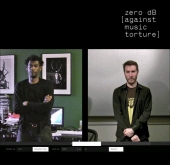Interview (Ticketmaster, September 2006)
Massive Attack's groundbreaking blend of hip hop, dub reggae, techno and rock revolutionized Britain's dance club scene in the early ‘90s and gave birth to the trip-hop sound that would eventually be popularized by such acclaimed artists as Portishead, Björk and Sneaker Pimps. All Massive Attack's albums to date are certified platinum and feature a dynamic roster of vocalists including Elizabeth Fraser, Horace Andy, Tracey Thorn and Sinead O'Connor. Comprised of Robert "3D" Del Naja and Grant "Daddy G" Marshall, the band has recently released Collected (a compilation of select works) and has plans to release a new album Weather Underground in early 2007. While on tour in the US, 3D spoke to Ticketmaster about Collected, their new record in the works, and their current tour.
TM: How did you come to the decision that it was time for a "best-of" album?
3D: To be honest it was kind of one of those things that had been looming for the last few years. It's a quite conventional thing to do in the UK and Europe... We were in this space where we were making our record and the record company wanted something. We thought ok, we give them something commercial and then we get some favors on the next record when we want to do something more unconventional and work with video directors or do something with the artwork which might not sort of add up to count in terms of the numbers and figures. But they'd feel a bit more obliged maybe, or more sort of likely to warm to some of our ideas. Especially in a business which is more difficult to squeeze money out of the companies now, you know.
TM: How did you go about selecting the tracks to include on it?
3D: It took about all of two minutes on a Post-It® note, you know what I mean? With a pencil and then filling it all in with marker afterwards after sort of changing my mind a few times. It was very, very obvious really. Only problem is on a CD you have to restrict it to 14 tracks and not 16, so you have to lose a couple, but you know.
TM: So was it mainly about chart success and they were less personal choices?
3D: No, because there are things on there that were never singles, which was kind of fun as well. So some singles and I also left a couple singles off which, normally, on a "best-of" is a complete no-no, so the record company weren't very happy with me. There were a few singles that weren't on there at all. But Collected has a really interesting second disc with new tracks and remixes and unheard things and unfinished sketches. And then the artwork, creating all the new artwork and working with (Jonathan) Glazer on the new video. That kind of stuff is the real interesting part of it.
TM: Yes, definitely. So let's talk about what's foremost on your fans' minds at the moment—your highly anticipated new album Weather Underground. How are you coming along and are you still on schedule for a Feb 2007 release?
3D: We'll see. We've obviously spent a lot of time on the road this year so we've lost quite a lot of time in the studio you know ... sometimes it's difficult because you're traveling and you're tired, you're playing. There's not a lot of time to really be doing any meaningful writing. So we might sort of lose that February vibe, but there's also a lot of work for me and G (Daddy G) to be listening to each other's things, to put our heads together and get back to a sort of space where we're going to work together on some things. But I guess a lot of it will be done separately like most of our albums that we've done in the past.
TM: Now what's that like working separately? Just logistically, how you do make it work?
3D: Well it's the way it's always been...from Blue Lines onwards. Mushroom would come in with an idea or G would come in with an idea, or I would come in with one and we'd work normally with an interface person—like a co-writer or co-producer—and then the other guys, or I would suggest something or someone would suggest something that adds life to someone else's idea. We've very rarely sat in the same room writing together. It's very unconventional in that way. It always has been and I guess it will never change. And I think that's the way this next record will be made. It wasn't a shock to me making 100th Window without anyone else because I've spent so much time in the studio without the guys anyway.
TM: How would you describe the direction of the new album?
3D: It's got a lot of different sort of angles going at the moment. But I don't think it's found its pure direction yet. I was very interested in getting a gothic soul approach out of it which is something I've tried a few times but it's more difficult than it seems. Trying to get the right voice with the right sort of musical textures. But we'll see (laughs).
TM: So who are some of the guest vocalists on the new record?
3D: Obviously we're working with Elizabeth Fraser and Horace Andy, but also Damon Albarn's on a track, Tunde from TV On The Radio's done a track. There are a few other things floating around but I'm not at liberty to say all of them yet because not all the songs have been developed enough and I don't want to jinx them by saying that they'll all be included.
TM: Of course. You worked on two film soundtracks since releasing your last album 100th Window. How has the experience of scoring music for a visual medium affected the way you're currently producing songs?
3D: It's fun in a strange manner and, a lot of people have said this before, it's liberating because you're not writing about yourself. You have to work to a picture and a storyline and therefore you have those restrictions that allow you to do something you might never do. And also you're not worried about how you see the history of the band as a part of that. And I think it does free you up to do some quite different things you might not think of doing which you can also then adopt in the writing process of another record because you have so much stuff you never use in the film. But they create little sketches and little moments you might want to build on to create tracks.
TM: So some of the music that you wrote for those two films we might hear on the new album?
3D: There's a couple of things, actually, yeah which were kind of left out of both of those films, which were quite nice basics or sort of like background parts for new songs. One of which we've written something on. I don't know if it will make the record because it's a little bit strange. But, yeah, it does have that possibility when you work that way.
TM: On the subject of visuals, how involved are you personally with creating the visual elements of your live shows?
3D: Well most of the ideas will come from me. And I work with an interface of a company called UV Artists (United Visual Artists) and we've worked with them for the last four or five years. I'll suggest things, we'll work on them together, they'll do the programming and bring it back to me—we'll talk about content, we'll talk about the light source, the strength of the light, the color of the light, the position of the lights, you know. The whole thing is a proper collaboration from beginning to end. It's the same way I've worked on all the (record) sleeves over the years, you know, working with photographers and the graphic designers to get exactly the sleeve we want to make. I mean that's the kind of thing that's not only exciting but it's vital to maintain your individuality as a band and people go "wow that belongs to that band and no one else."
TM: So you do consider the visual aspect to be an integral part of your live shows?
3D: Definitely. Definitely. As much as the sleeves are. It's always been about the visual with us. I think it's helped us enforce our identity as something tangible. Massive Attack being something that people go "right, I hear the music, I reckon it's them," you know what I mean? I see something visual, I reckon it could be them even without knowing for sure. In an age where there's so much visual and aural medium out there, music's got a lot cheaper and it's more competitive. To maintain and keep an identity together is really what it's about and I think we've always done that and using visuals as opposed to our own faces and our own personalities to sell ourselves, it's given us this room to maneuver.
TM: And who does your tour line-up consist of this time around?
3D: On the tour we've got... Elizabeth Fraser's with us and Deborah Miller who's been singing with us for the last decade; Horace Andy's with us; obviously myself; we've got two drummers now instead of one which is really kind of funky; guitars; bass; guitarist Angelo Bruschini's been working with us now for over ten years; and keyboards. So the line-up, mostly, is people we've known and worked with for the last ten years so it feels very tight as a live unit. We travel together. We eat together.
TM: Are you playing a lot of new material on your current tour?
3D: Not much really. Lots of stuff we dropped out. We started rehearsing it, but we've not used it. I think mainly because the tracks are either not developed enough or because we're dynamically changing everything. Because the two drummers scenario changed a lot of arrangements I think...it's alright messing around with arrangements with tracks that you know because you have the ability to really destroy them again and rebuild them, but I think the problem is with new tracks, they've not yet established themselves in any way. Not in your mind let alone transmitted to an audience...We were already adapting them and changing them but they weren't necessarily strengthening the ideas; it was actually making (us think) "well, what is this?" No one's gonna know what it is and we've forgotten what it is now because we've changed it so much.
TM: Alright. So one last question for you. Who are some current artists that you admire?
3D: Neil Young and Michael Franti.








